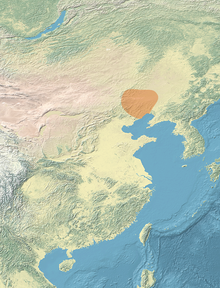General location of the Upper Xiajiadian culture, and contemporary Asian polities c. 1000 BCE | |
| Dates | 1000–600 BCE |
|---|---|
| Preceded by | Lower Xiajiadian culture |
| Followed by | Jinggouzi culture Donghu people (600–150 BCE)[1] |



The Upper Xiajiadian culture (simplified Chinese: 夏家店上层文化; traditional Chinese: 夏家店上層文化; pinyin: Xià jiā diàn shàngcéng wénhuà) (c. 1000–600 BCE[5]) was a Bronze Age archaeological culture in Northeast China derived from the Eurasian steppe bronze tradition.[6] It is associated with the Donghu ("Eastern Barbarians") of Chinese history.
- ^ a b Drennan, Robert D. (2014). "Settlement and Social Dynamics in the Upper Daling and Chifeng Regions of Northeastern China". Asian Archaeology. 2: 50–76.
- ^ Psarras, Sophia-Karin (January 1999). "Upper Xiajiadian". Monumenta Serica. 47 (1): 90, Figure 19. doi:10.1080/02549948.1999.11731324.
- ^ "Certificate".
- ^ Rawson, Jessica (2020). "Chariotry and Prone Burials: Reassessing Late Shang China's Relationship with Its Northern Neighbours". Journal of World Prehistory. 33 (2): 138–168. doi:10.1007/s10963-020-09142-4. S2CID 254751158.
- ^ Shelach, pp. 143
- ^ Barnes, pp. 153
